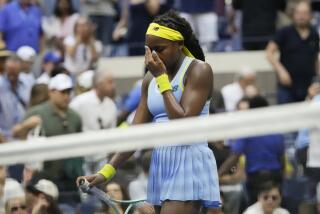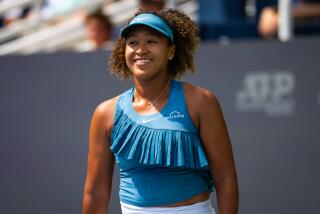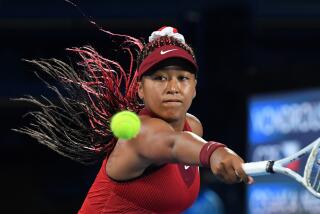Davenport Weighing Options After Being Run Off the Court : Tennis: Endo’s straight-set victory leaves sixth-seeded player frustrated and groping for ways to get faster and reach next level.
- Share via
NEW YORK — Lindsay Davenport, her tennis career moving much faster than her feet, stumbled in the third round of the U.S. Open on Saturday.
The 18-year-old Murrieta standout whose world ranking has improved since January from No. 20 to No. 7, sending her into the Open with the highest seeding of any American woman at No. 6, was beaten by the element of speed. Her opponent had it and she didn’t.
Ousting Davenport was 23-year-old Mana Endo of Japan, who scurried all over the court for a 6-3, 7-6 (7-1) victory that allowed her to advance for the first time to the round of 16 in a Grand Slam event.
Endo ran down everything the hard-hitting Davenport sent at her and closed out the match in the tiebreaker--after serving for it and failing at 5-4 of the second set--by sprinting after a drop shot for 2-0 and cracking a forehand past Davenport at the net for 6-1. On match point, a sagging Davenport hit a forehand long.
“I didn’t feel really physically tired,” Davenport said. “I just didn’t really move well, and it was a little hard to catch my breath. She was taking every shot I took and coming back with one better. That’s tough to play against.”
The central issues of this match were size, speed and endurance. Endo’s size, 5 feet 3 and 119 pounds, went against Davenport’s 6-2 and 165 and proved quickly that bigger isn’t always better; in this case, not always faster, either. David and Goliath imagery was not too extreme a stretch for this match.
The endurance issue is an entirely different thing, and that aspect of Davenport’s performances has been dealt with delicately this week. Because Davenport is only 18, and because she is so liked and likable, other players tiptoe around it in conversation and interviews. And the press, when posing questions to, or about, Davenport, carefully avoids use of the W word.
But the consensus is clear, the need obvious, even to Davenport, who answers carefully phrased questions with carefully phrased answers. To take her game to the next level, she needs to lose weight.
Among the things on that topic that Davenport said Saturday were:
--”I really couldn’t get my legs into the ball. . . . “
--”I think I should come into the net more, but I just don’t feel, I just don’t move around very well at the net. I don’t feel like I’m nimble enough to go cover those volleys.”
Pam Shriver, who was yanked all around the court earlier this week in a 6-1, 6-2 rout by Davenport, spoke after that match from her perspective as the elder stateswoman here at 34, as the only player in the tournament who has played here in the last three decades, and as a player who admires Davenport.
“She is not that unfit, I mean, she obviously is a big gal and she does carry a little extra,” Shriver said. “But that doesn’t mean that somebody is not in pretty doggone good shape. . . . I don’t think it should be written that she is in horrible shape, because I don’t think she is. I just think she is not in the kind of Steffi Graf shape.”
Davenport will play a tournament in Japan after the U.S. Open, then return home for more than a month to train and work with a San Francisco doctor named Don Chu, whom she called both a medical doctor and a trainer.
“Maybe he can tell me what I need to do (to get faster),” she said. “He knows some secrets.”
With Martina Navratilova about to retire, and the futures of Monica Seles and Jennifer Capriati uncertain, Davenport’s progress has generated increased interest. For one thing, her status as the highest-seeded American female made her the first player since 1974 to achieve that status other than Chris Evert, Mary Joe Fernandez, Tracy Austin and Navratilova. And Fernandez and Austin held the spot only once each.
Only four American women remain in the round of 16, and only Zina Garrison Jackson at No. 10 is seeded. The others are Gigi Fernandez, Ginger Helgeson and Ann Grossman.
Garrison Jackson survived a tremendous struggle Saturday on Court 16, taking 2 hours 25 minutes to get past unheralded Alexia Dechaume-Balleret of France, 2-6, 6-4, 7-6 (7-1). In the third set, Dechaume-Balleret, No. 68 in the world, saved 14 break points in a match as tense and closely contested as any here so far.
“In the third set, I just stayed very tough, and she did, too,” Garrison Jackson said. “We went to the tiebreaker and I just hit five great volleys. You should win a tiebreaker if you play like that.”
Today, Grossman will play No. 2 Arantxa Sanchez Vicario in the afternoon and Gigi Fernandez will play Helgeson at night. Monday, Garrison Jackson will play Graf. The likely scenario would leave American women with one quarterfinalist, the Fernandez-Helgeson winner.
Thanks to Endo’s victory over Davenport, the Japanese, with little international tennis tradition, could well double that, if No. 5 Kimiko Date plays to her seeding Sunday and Endo can run another opponent off the court on Monday.
Such is the state of American women’s tennis. One might call it a weighty problem.
More to Read
Go beyond the scoreboard
Get the latest on L.A.'s teams in the daily Sports Report newsletter.
You may occasionally receive promotional content from the Los Angeles Times.











